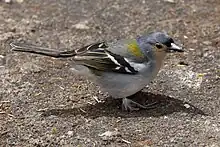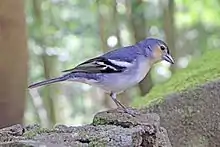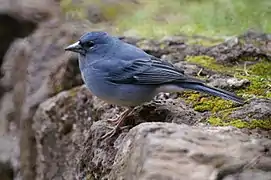Fringilla
The genus Fringilla is a small group of finches from the Old World, which are the only species in the subfamily Fringillinae. The genus name Fringilla is Latin for "finch".
| Fringilla | |
|---|---|
 | |
| Male Eurasian chaffinch | |
| Scientific classification | |
| Domain: | Eukaryota |
| Kingdom: | Animalia |
| Phylum: | Chordata |
| Clade: | Dinosauria |
| Class: | Aves |
| Order: | Passeriformes |
| Family: | Fringillidae |
| Subfamily: | Fringillinae Leach, 1820 |
| Genus: | Fringilla Linnaeus, 1758 |
| Type species | |
| Fringilla coelebs | |
| Species | |
Taxonomy
The genus Fringilla was introduced in 1758 by the Swedish naturalist Carl Linnaeus in the tenth edition of his Systema Naturae.[1] The genus name Fringilla is Latin for "finch".[2] Linnaeus included 30 species in the genus (Fringilla zena was listed twice) and of these the common chaffinch (Fringilla coelebs) is considered as the type species.[3]
Species
The genus now contains eight species:[4]
| Image | Scientific name | Common name | Distribution |
|---|---|---|---|
.jpg.webp) | Fringilla coelebs | Eurasian chaffinch | Europe, across Asia to Siberia |
_Morocco.jpg.webp) | Fringilla spodiogenys | African chaffinch | northwestern Africa |
.jpg.webp) | Fringilla moreletti | Azores chaffinch | Azores |
 | Fringilla maderensis | Madeiran chaffinch | Madeira |
 | Fringilla canariensis | Canary Islands chaffinch | Canary Islands |
%252C_M._A._Pe%C3%B1a.jpg.webp) | Fringilla polatzeki | Gran Canaria blue chaffinch | Gran Canaria, Canary Islands |
 | Fringilla teydea | Tenerife blue chaffinch | Tenerife, Canary Islands |
 | Fringilla montifringilla | Brambling | Europe, North Africa, northern India, northern Pakistan, China, and Japan |
The common chaffinch is found primarily in forest habitats, in Europe, North Africa, and western Asia; the blue chaffinches are island endemics; and the brambling breeds in the northern taiga and southern tundra of Eurasia.[5]
The four species are about the same size, 15 centimetres (5.9 in) in length, and are similar in shape.[5] They have a bouncing flight with alternating bouts of flapping and gliding on closed wings.[6] They are not as specialised as other finches, eating both insects and seeds. While breeding, they feed their young on insects rather than seeds, unlike other finches.[5]
In 2016, it was proposed that the extremely rare Gran Canaria subspecies F. teydea polatzeki be treated as a separate species, thus creating a fourth species, F. polatzeki.[7][8]
References
- Linnaeus, Carl (1758). Systema Naturae per regna tria naturae, secundum classes, ordines, genera, species, cum characteribus, differentiis, synonymis, locis (in Latin). Vol. 1 (10th ed.). Holmiae (Stockholm): Laurentii Salvii. p. 179.
- Jobling, James A. (2010). The Helm Dictionary of Scientific Bird Names. London, United Kingdom: Christopher Helm. p. 164. ISBN 978-1-4081-2501-4.
- Paynter, Raymond A. Jr, ed. (1968). Check-List of Birds of the World. Vol. 14. Cambridge, Massachusetts: Museum of Comparative Zoology. p. 203.
- Gill, Frank; Donsker, David (eds.). "Finches, euphonias". World Bird List Version 5.2. International Ornithologists' Union. Retrieved 5 June 2015.
- Newton, Ian (1973). Finches. New Naturalist 55. New York: Taplinger. pp. 19–30. ISBN 0-8008-2720-1.
- Clement, Peter; Harris, Alan; Davis, John (1993). Finches and Sparrows. Princeton, New Jersey: Princeton University Press. ISBN 0-691-03424-9.
- Sangster, G.; Rodríguez‐Godoy, F.; Roselaar, C.S.; Robb, M.S.; Luksenburg, J.A. (2016). "Integrative taxonomy reveals Europe's rarest songbird species, the Gran Canaria blue chaffinch Fringilla polatzeki". Journal of Avian Biology. 47 (2): 159–166. doi:10.1111/jav.00825.
- "The Rarest Songbird in Europe". Wildlife Articles. Archived from the original on 2016-03-08. Retrieved 2016-03-05.